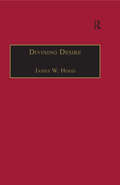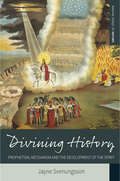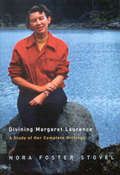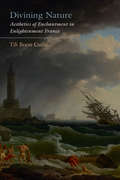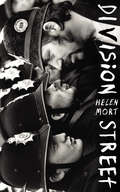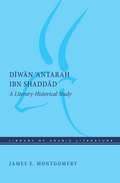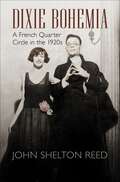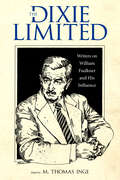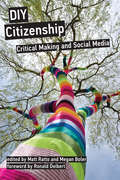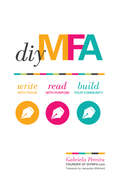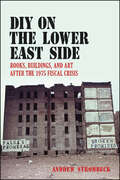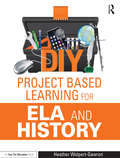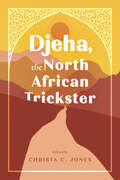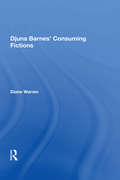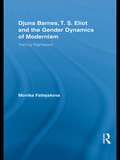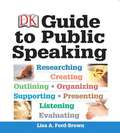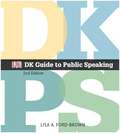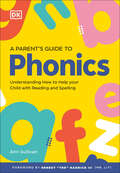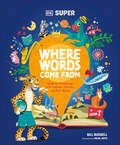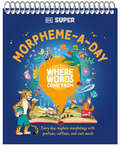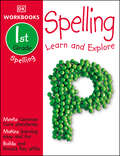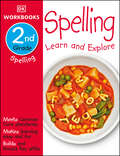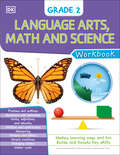- Table View
- List View
Divining Desire: Tennyson and the Poetics of Transcendence (The Nineteenth Century Series)
by James W. HoodThis study examines Tennyson's portrayals of the erotic and creative impulses, reading the poet's ubiquitous lover-artists as tropes that figure the desire for transcending the state of being human, a condition of personal fragmentation and limited knowledge. Ostensibly seeking to fulfill erotic wishes, construct utopias, or create grand artistic works, Tennyson's characters engage in a fundamentally spiritual quest, yearning to divine desire: to eternalize the fulfilment of their deepest wishes. Freud revealed how Victorians sublimated sexual desire into religious impulse. This book demonstrates, however, the remarkable way in which Tennyson's poems transact the opposing projection, transfiguring spiritual desire into erotic art. Brilliantly negotiating a middle ground between scientific skepticism and reactionary religiosity, his vastly popular poems suggest that fulfilment of "the wish too strong for words to name" lies in a sacramentality: only as means do art and eros allow transport beyond fragmentation. At a deep level, the poems conclude that language itself brokers transcendence through its very brokenness.
Divining History: Prophetism, Messianism and the Development of the Spirit (Making Sense of History #26)
by Jayne SvenungssonFor millennia, messianic visions of redemption have inspired men and women to turn against unjust and oppressive orders. Yet these very same traditions are regularly decried as antecedents to the violent and authoritarian ideologies of modernity. Informed in equal parts by theology and historical theory, this book offers a provocative exploration of this double-edged legacy. Author Jayne Svenungsson rigorously pursues a middle path between utopian arrogance and an enervated postmodernism, assessing the impact of Jewish and Christian theologies of history on subsequent thinkers, and in the process identifying a web of spiritual and intellectual motifs extending from ancient Jewish prophets to contemporary radicals such as Giorgio Agamben and Slavoj Zizek.
Divining Margaret Laurence
by Nora Foster StovelWhereas previous studies focus on certain aspects of her work, Divining Margaret Laurence addresses all her important writings, including a final, unfinished manuscript - "Dance on the Earth: A Memoir." This comprehensive study of her writings, including archival material, allows Nora Stovel to trace the development of Laurence's Canadian identity, feminist sympathies, moral vision, and creative artistry.
Divining Margaret Laurence: A Study of Her Complete Writings
by Nora Foster StovelMargaret Laurence is justly famous for her Manawaka cycle of Canadian novels, but her work extends from Canada to Africa and includes poetry and prose, children's and adult literature, memoir and travel-writing.
Divining Nature: Aesthetics of Enchantment in Enlightenment France
by Tili Boon CuilléThe Enlightenment remains widely associated with the rise of scientific progress and the loss of religious faith, a dual tendency that is thought to have contributed to the disenchantment of the world. In her wide-ranging and richly illustrated book, Tili Boon Cuillé questions the accuracy of this narrative by investigating the fate of the marvelous in the age of reason. Exploring the affinities between the natural sciences and the fine arts, Cuillé examines the representation of natural phenomena—whether harmonious or discordant—in natural history, painting, opera, and the novel from Buffon and Rameau to Ossian and Staël. She demonstrates that philosophical, artistic, and emotional responses to the "spectacle of nature" in eighteenth-century France included wonder, enthusiasm, melancholy, and the "sentiment of divinity." These "passions of the soul," traditionally associated with religion and considered antithetical to enlightenment, were linked to the faculties of reason, imagination, and memory that structured Diderot's Encyclopédie and to contemporary theorizations of the sublime. As Cuillé reveals, the marvelous was not eradicated but instead preserved through the establishment and reform of major French cultural institutions dedicated to science, art, religion, and folklore that were designed to inform, enchant, and persuade. This book has been made possible in part by the National Endowment for the Humanities: Exploring the human endeavor.
Division Street
by Helen Mort*SHORTLISTED FOR THE T.S ELIOT PRIZE AND COSTA POETRY AWARD 2013*'A stone is lobbed in '84, hangs like a star over Orgreave. Welcome to Sheffield. Border-land,our town of miracles...' - 'Scab'From the clash between striking miners and police to the delicate conflicts in personal relationships, Helen Mort's stunning debut is marked by distance and division. Named for a street in Sheffield, this is a collection that cherishes specificity: the particularity of names; the reflections the world throws back at us; the precise moment of a realisation. Distinctive and assured, these poems show us how, at the site of conflict, a moment of reconciliation can be born.
Diwan 'Antarah ibn Shaddad: A Literary-Historical Study (Library of Arabic Literature #56)
by James E. MontgomeryThe pre-Islamic warrior-poet 'Antarah ibn Shaddad, a composer of one of the Mu'allaqat, attracted the attention of the philologists who were active in Iraq at the nascence of the scholarly study of Arabic. These philologists collected and studied the diwan of 'Antarah as part of their recovery and codification of the Jahiliyyah: 'Antarah became one of the Six Poets, a collection of pre-Islamic poets associated with al-Asma'i, “the father of Arabic philology.” Two centuries later, in al-Andalus, al-Shantamari and al-Batalyawsi composed their commentaries on the diwans of the Six Poets. This study uncovers the literary history of 'Antarah’s diwan and presents five editions, with critical apparatus, of the extant recensions, based on an extensive collation of the surviving manuscripts.An Arabic edition with English scholarly apparatus.
Dixie Bohemia: A French Quarter Circle in the 1920s (Walter Lynwood Fleming Lectures in Southern History)
by John Shelton ReedIn the years following World War I, the New Orleans French Quarter attracted artists and writers with its low rents, faded charm, and colorful street life. By the 1920s Jackson Square had become the center of a vibrant if short-lived bohemia. A young William Faulkner and his roommate William Spratling, an artist who taught at Tulane University, resided among the "artful and crafty ones of the French Quarter." In Dixie Bohemia John Shelton Reed introduces Faulkner's circle of friends -- ranging from the distinguished Sherwood Anderson to a gender-bending Mardi Gras costume designer -- and brings to life the people and places of New Orleans in the Jazz Age.Reed begins with Faulkner and Spratling's self-published homage to their fellow bohemians, "Sherwood Anderson and Other Famous Creoles." The book contained 43 sketches of New Orleans artists, by Spratling, with captions and a short introduction by Faulkner. The title served as a rather obscure joke: Sherwood was not a Creole and neither were most of the people featured. But with Reed's commentary, these profiles serve as an entry into the world of artists and writers that dined on Decatur Street, attended masked balls, and blatantly ignored the Prohibition Act. These men and women also helped to establish New Orleans institutions such as the Double Dealer literary magazine, the Arts and Crafts Club, and Le Petit Theatre. But unlike most bohemias, the one in New Orleans existed as a whites-only affair. Though some of the bohemians were relatively progressive, and many employed African American material in their own work, few of them knew or cared about what was going on across town among the city's black intellectuals and artists.The positive developments from this French Quarter renaissance, however, attracted attention and visitors, inspiring the historic preservation and commercial revitalization that turned the area into a tourist destination. Predictably, this gentrification drove out many of the working artists and writers who had helped revive the area. As Reed points out, one resident who identified herself as an "artist" on the 1920 federal census gave her occupation in 1930 as "saleslady, real estate," reflecting the decline of an active artistic class. A charming and insightful glimpse into an era, Dixie Bohemia describes the writers, artists, poseurs, and hangers-on in the New Orleans art scene of the 1920s and illuminates how this dazzling world faded as quickly as it began.
The Dixie Limited: Writers on William Faulkner and His Influence
by M. Thomas IngeFlannery O'Connor once noted, “The presence alone of Faulkner in our midst makes a great difference in what the writer can and cannot permit himself to do. Nobody wants his mule and wagon stalled on the same track the Dixie Limited is roaring down.” Her railroading metaphor wittily captures much of the respect and unease Faulkner's example brought the worldwide community of authors. Few other writers have exerted as profound an influence on literature as Faulkner. Prominent literary scholar M. Thomas Inge documents the scope of his influence in the twentieth century through the words of those writers themselves. This collection of essays offers a survey attempting to capture exactly what Faulkner meant to his literary peers and colleagues both in the United States and abroad. Inge has combed essays, articles, reviews, letters, and comments written by over forty novelists, poets, and playwrights about Faulkner's fiction and the power of his literary accomplishment. Many major American writers sound off here, as well as important figures from France, England, Japan, and South America. Some speak about his technical virtuosity and how this expertise has directly influenced them, and others express the difficulties of trying to escape his example. A few even criticize him for what they see as artistic failures. The variety of responses demonstrate, in any case, that Faulkner created an unavoidable power in his own time and remains a permanent force in literature.
DIY Citizenship: Critical Making and Social Media (The\mit Press Ser.)
by Megan Boler Matt RattoHow social media and DIY communities have enabled new forms of political participation that emphasize doing and making rather than passive consumption.Today, DIY—do-it-yourself—describes more than self-taught carpentry. Social media enables DIY citizens to organize and protest in new ways (as in Egypt's “Twitter revolution” of 2011) and to repurpose corporate content (or create new user-generated content) in order to offer political counternarratives. This book examines the usefulness and limits of DIY citizenship, exploring the diverse forms of political participation and “critical making” that have emerged in recent years. The authors and artists in this collection describe DIY citizens whose activities range from activist fan blogging and video production to knitting and the creation of community gardens.Contributors examine DIY activism, describing new modes of civic engagement that include Harry Potter fan activism and the activities of the Yes Men. They consider DIY making in learning, culture, hacking, and the arts, including do-it-yourself media production and collaborative documentary making. They discuss DIY and design and how citizens can unlock the black box of technological infrastructures to engage and innovate open and participatory critical making. And they explore DIY and media, describing activists' efforts to remake and reimagine media and the public sphere. As these chapters make clear, DIY is characterized by its emphasis on “doing” and making rather than passive consumption. DIY citizens assume active roles as interventionists, makers, hackers, modders, and tinkerers, in pursuit of new forms of engaged and participatory democracy.ContributorsMike Ananny, Chris Atton, Alexandra Bal, Megan Boler, Catherine Burwell, Red Chidgey, Andrew Clement, Negin Dahya, Suzanne de Castell, Carl DiSalvo, Kevin Driscoll, Christina Dunbar-Hester, Joseph Ferenbok, Stephanie Fisher, Miki Foster, Stephen Gilbert, Henry Jenkins, Jennifer Jenson, Yasmin B. Kafai, Ann Light, Steve Mann, Joel McKim, Brenda McPhail, Owen McSwiney, Joshua McVeigh-Schultz, Graham Meikle, Emily Rose Michaud, Kate Milberry, Michael Murphy, Jason Nolan, Kate Orton-Johnson, Kylie A. Peppler, David J. Phillips, Karen Pollock, Matt Ratto, Ian Reilly, Rosa Reitsamer, Mandy Rose, Daniela K. Rosner, Yukari Seko, Karen Louise Smith, Lana Swartz, Alex Tichine, Jennette Weber, Elke Zobl
DIY MFA: Write with Focus, Read with Purpose, Build Your Community
by Jacquelyn Mitchard Gabriela PereiraGet the Knowledge Without the College! You are a writer. You dream of sharing your words with the world, and you're willing to put in the hard work to achieve success. You may have even considered earning your MFA, but for whatever reason--tuition costs, the time commitment, or other responsibilities--you've never been able to do it. Or maybe you've been looking for a self-guided approach so you don't have to go back to school. This book is for you.DIY MFA is the do-it-yourself alternative to a Master of Fine Arts in creative writing. By combining the three main components of a traditional MFA--writing, reading, and community--it teaches you how to craft compelling stories, engage your readers, and publish your work. Inside you'll learn how to:Set customized goals for writing and learning.Generate ideas on demand.Outline your book from beginning to end.Breathe life into your characters.Master point of view, voice, dialogue, and more.Read with a "writer's eye" to emulate the techniques of others.Network like a pro, get the most out of writing workshops, and submit your work successfully.Writing belongs to everyone--not only those who earn a degree. With DIY MFA, you can take charge of your writing, produce high-quality work, get published, and build a writing career.
DIY on the Lower East Side: Books, Buildings, and Art after the 1975 Fiscal Crisis
by Andrew StrombeckThe severe financial austerity imposed on New York City during the 1975 fiscal crisis resulted in a city falling apart. Broken windows, crumbling walls, and piles of bricks were everywhere. While, for many, this physical decay was a sign that the postwar welfare state had failed, for others, it represented a site of risky opportunity that could stimulate novel forms of creativity and community. In this book, Andrew Strombeck explores the legacy of this crisis for the city's literature and art, focusing on one neighborhood where changes were acutely felt—the Lower East Side.In what became a paradigmatic example of gentrification, the Lower East Side's population shifted from working-class people to Wall Street traders and ad agents. This transformation occurred, in part, because of high-profile local artists such as Jean-Michel Basquiat, Keith Haring, Jeff Koons, and Kiki Smith, but Strombeck argues that neighborhood writers also played a role. Drawing on archival research and original author interviews, he examines the innovative work of Kathy Acker, David Wojnarowicz, Miguel Piñero, Sylvère Lotringer, Lynne Tillman, and others and concludes that these writers still have much to teach us about changes in the nature of work and the emergence of a do-it-yourself ethos. DIY on the Lower East Side shows how place and politics shaped literature, and how New York City policies adopted at the time continue to shape our world.
DIY Project Based Learning for ELA and History
by Heather Wolpert-GawronAre you interested in using Project Based Learning to revamp your lessons, but aren’t sure how to get started? In DIY Project Based Learning in ELA and History, award-winning teacher and Edutopia blogger Heather Wolpert-Gawron makes it fun and easy! Project Based Learning encourages students and teachers alike to abandon their dusty textbooks, and instead embrace a form of curriculum design focused on student engagement, innovation, and creative problem-solving. A leading name in this field, Heather Wolpert-Gawron shares some of her most popular units for ELA and Social Studies in this exciting new collection. This book is an essential resource for teachers looking to: Create their own Project Based Learning units. Engage student in their education by grounding lessons in real-world problems and encouraging them to develop creative solutions. Incorporate role-playing into everyday learning. Develop real-world lessons to get students to understand the life-long relevance of what they are learning. Assess multiple skills and subject areas in an integrated way. Collaborate with teachers across subject areas. Test authentic skills and set authentic goals for their students to grow as individuals. Part I of the book features six full units, complete with student samples, targeted rubrics, a checklist to keep students on track, and even "Homework Hints." Part II is a mix-and-match section of tools you can use to create your own PBL-aligned lessons. The tools are available as eResources on our website, http://www.routledge.com/books/details/9781138891623, so you can print and use them in your classroom immediately.
Djeha, the North African Trickster
by Christa C. JonesDjeha—also known as Juha, Jeh’a, and Ch’ha, among many variations—is an iconic figure, the trickster hero of an oral folktale tradition that has existed for centuries. The famous Maghrebian prankster is a poor, cunning, and resourceful character that delights in immoral behavior. Orientalists Auguste Mouliéras (1855-1931) and René Basset (1855-1924) were among the first Frenchmen to collect and translate popular Berber folktales. Today, trickster folktales from Algeria’s mountainous Kabylia region are not well known in the Anglophone world, even though they continue to be highly popular in France and in North Africa. Djeha, the North African Trickster is an annotated, critical translation of Auguste Mouliéras’s folktale collection Les Fourberies de Si Djeh’a, first published in French in 1892.The volume contains sixty tales and an in-depth introduction in which Christa C. Jones discusses jocular literature in Islam, the widespread oral folktale tradition linked to Djeha and his Turkish twin brother Nasreddin Hoca, and the impact of colonialism on the gathering and dissemination of the tales. The trickster is at the center of six themed chapters: “Family and Kinship”; “Animal Tales"; “Faces, Places, or Daily Life in the Village"; “Foodways”; “The Intricacies of Hospitality: Beware of Friends and Foes!"; and “Religion, Death, and the Afterlife.” Each chapter contains ten folktales preceded by a short introduction that contextualizes the pieces using historical, folkloristic, literary, and ethnographical sources. Ultimately, the book contributes to the preservation of an ancestral oral heritage, delivering this enduring character to new audiences.
Djuna Barnes' Consuming Fictions
by Diane WarrenDjuna Barnes (1892-1982) was a pioneering female journalist, experimental novelist, playwright, and poet whose influence on literary modernism was profound and whose writings anticipated many of the preoccupations of poststructuralist and feminist thought. In her new book,the author argues that Barnes' writings made significant contributions to gender and aesthetic debates in their immediate early twentieth-century context, and that they continue to contribute to present-day debates on identity. In particular, Warren traces the works' close engagement with the effects of cultural boundaries on the individual, showing how the journalism, Ryder, Ladies Almanack, and the early chapters of Nightwood energetically and playfully subvert such boundaries. In this reading, Nightwood is contextualised as a pivotal text which poses questions about the limits of subversion, thereby positioning The Antiphon (1958) as an analysis of why such boundaries are sometimes necessary. Djuna Barnes' Consuming Fictions shows that from the irreverent and carnivalesque iconoclasm of Barnes' early works, to the bleak assessment that conflict lies at the root of culture, seen from the close of Nightwood, Barnes' oeuvre offers a profound analysis of the relationship between culture, the individual and textual expression.
Djuna Barnes, T. S. Eliot and the Gender Dynamics of Modernism: Tracing Nightwood
by Monika FaltejskovaThis study looks at the origins of the modernist movement, linking gender, modernism and the literary, before considering the bearing these discourses had on Djuna Barnes's writing. The main contribution of this innovative and scholarly work is the exploration of the editorial changes that T. S. Eliot made to the manuscript of Nightwood, as well as the revisions of the early drafts initiated by Emily Holmes Coleman. The archival research presented here is a significant advance in the scholarship, making this volume invaluable to both teachers and students of modern literature and Barnesian scholars.
DK Guide to Public Speaking
by Lisa A. Ford-BrownCombining its comprehensive coverage with the powerfully visual DK design, the student- and instructor-tested DK Guide to Public Speaking offers an easy-to-navigate resource with dynamic visuals, current examples, and concise instruction that will equip students with the tools and confidence to be effective speakers.
DK Guide To Public Speaking
by Lisa A. Ford-Brown Dorling Kindersley Publishing StaffMost visual, easiest to use With its powerful visual design and comprehensive scope, the DK Guide to Public Speaking, 2/e, is an easy-to-navigate resource that will equip students with the tools to be effective public speakers. Based on extensive research and usability studies, this full-color, tabbed, spiral-bound guidebook gives students the practical information they seek, supported with the concepts and theories instructors want. MyCommunicationLab is an integral part of the Ford-Brown program that will help enhance students' presentation skills. With MediaShare, students can post and share videos of their speeches for peer commenting and instructor commenting and grading. Also, interactive videos provide students with the opportunity to evaluate speeches. Online self-assessments and pre- and post-tests help students assess their comfort level with public speaking and their knowledge of the material. Note: MyCommunicationLab does come automatically packaged with this text.
The DK Handbook Second Edition with Exercises
by Dennis A. Lynch Anne Frances WysockiTransforming expectations for textbooks, The DK Handbook with Exercises 2/e presents information in newly accessible, scientifically tested, and student-friendly ways. Never before seen in the handbook market, The DK Handbook's design is a true marriage of visual and textual content, in which each topic is presented in self-contained, two-page spreads for at-a-glance referencing. Explanations are concise and "chunked" to be more approachable and appealing for today's readers, and accompanying visuals truly teach - making concepts and processes visible to students. The ground-breaking layout creates a consistent look and feel that helps students connect with the material, find information, and recognize solutions to writing problems they often don't have names for.
DK Super Phonics A Parent's Guide to Phonics (DK Super Phonics )
by DKHelp your child take their first steps into the world of phonics and reading with this parent's and caregiver’s guide to reading support.A Parents Guide to Phonics is for parents and caregivers who want to learn how to help their child with reading and spelling. It explains how written language is put together, what phonics is, and how reading and spelling are taught using a structured approach.The book is written using accessible, jargon-free language that is easy to follow and understand. It also includes a section on additional educational needs and what adaptations schools might make to enable pupils with additional needs to access phonics teaching.This parent guide to teaching phonics offers: - An easy-to-understand guide to teaching phonics, with jargon-free language that is easy to follow.- An opportunity to boost home learning for parents and caregivers who want to support their children with phonics at home.- A Science of Reading approach, using a structured approach to teaching and understanding phonics. Written for parents and caregivers and those new to supporting children learning to read, A Parent’s Guide to Phonics explains how written language is put together, what phonics is and how reading and spelling are taught using a structured approach.What is phonics?Phonics is a way of teaching children to read by understanding the sounds that individual letters make and blending them to make a word. Children can learn to read using this skill to decode new words. Phonic Books specialzes in decodable, systematic books supporting this structured literacy instruction.
DK SUPER Where Words Come From: Guide to Morphology with Prefixes, Suffixes, and Root Words (DK Super)
by DKDelve into the fascinating world of morphemes, word formation, and discovery with this visual reference book, designed for curious young readersDK Super Where Words Come From is the ultimate guide for learning more about morphology and the origins of words. Discover amazing facts about the building blocks of language – from prefixes and suffixes to root words and bases.This morphology book for children offers:A guide to understanding word formation through prefixes, suffixes, and root words.A highly visual approach that makes association between words and where they originate easier to understand.Material to help children become more confident readers, speakers, and spellers through learning etymology, prefixes, and suffixes. Discover over 100 morphemes in this book and improve morphological awareness, a powerful tool in supporting the five pillars of reading. This also includes boosting vocabulary, improving spelling skills, and enhancing reading comprehension.Don’t just read words, understand them!
DK SUPER Where Words Come From Morpheme-a-Day (DK Super)
by DKDelve into the fascinating world of morphemes, word formation, and discovery with this visual flip book designed for curious young readers.DK Super Where Words Come From Morpheme-a-Day is the fundamental guide for children aged 7-11 who want to learn about morphology and the origins of words. Every day, flip the page and discover a new, beautifully illustrated morpheme. Ideal for front-of-class interventions or small group instruction, this linguistics book breaks down key morphemes and provides activity ideas to build and develop students' knowledge.This morphology book for children offers:A guide to understanding word formation through prefixes, suffixes, and root words.A highly visual approach that makes association between words and where they originate easier to understand.Follows up on learning etymology, prefixes, suffixes, and Latin and Greek roots to enhance children’s decoding, spelling, and vocabulary. Discover over 100 morphemes in this book and improve morphological awareness, a powerful tool in supporting the five pillars of reading. This also includes boosting vocabulary, improving spelling skills and enhancing reading comprehension.Don’t just read words, understand them!More in the seriesIf you enjoyed DK Super Where Words Come From Morpheme-a-Day, then you’ll love the other titles in this linguistic series. Why not try DK Super Where Words Come From to learn more about the origins of words, or the supplementing activity book to put previously learned material into practice?
DK Workbooks: Learn and Explore (DK Workbooks)
by DKPLEASE NOTE - this is a replica of the print book, but you will be able to download printable worksheets on purchase.Perfect for children ages 6–7, this workbook supports your child's spelling and word-formation skills. Topics covered in this workbook include beginning and ending conconants, vowel teams, consonant blends, and beginning and ending digraphs.Level by level, the write-in DK Workbooks: Spelling series offers at-home practice that kids actually enjoy, making them ideal supplements to schoolwork. Designed to support curriculum standards, this series is developed with leading educational experts to build confidence and understanding.For children ages 3–9, each leveled workbook is packed with activities and challenges, offering the beneficial repetition and cumulative learning that lead to mastery. Fact boxes on each page give a simple overview of the topics being covered, review the basics, and often offer an example of the task at hand. The exercises themselves reinforce key spelling topics, including: vowel sounds, syllables, irregularly spelled words, reading simple sentences, and more. And with a parents' section filled with answers, tips, and guidance, caregivers have easy access to all the expertise they need to help their children learn spelling.
DK Workbooks: Learn and Explore (DK Workbooks)
by DKPLEASE NOTE - this is a replica of the print book, but you will be able to download printable worksheets on purchase.Perfect for children ages 7–8, this workbook helps build children's confidence in spelling words. Second graders learn to use different vowel teams, prefixes, suffixes, synonyms, antonyms, and homophones, and more.Level by level, the write-in DK Workbooks: Spelling series offers at-home practice that kids actually enjoy, making them ideal supplements to schoolwork. Designed to support curriculum standards, this series is developed with leading educational experts to build confidence and understanding.For children ages 3–9, each leveled workbook is packed with activities and challenges, offering the beneficial repetition and cumulative learning that lead to mastery. Fact boxes on each page give a simple overview of the topics being covered, review the basics, and often offer an example of the task at hand. The exercises themselves reinforce key spelling topics, including: vowel sounds, syllables, irregularly spelled words, reading simple sentences, and more. And with a parents' section filled with answers, tips, and guidance, caregivers have easy access to all the expertise they need to help their children learn spelling.
DK Workbooks: Language Arts Math and Science Grade 2 (DK Workbooks)
by DKBoost your child's skills with fun activities and exercises that introduce key concepts in spelling, math, and science.Whether you want to teach your child at home, give them extra support outside the classroom, or find fun stimulation for your budding genius, this workbook has something for everyone. Home learning can be fun with these exercises, featuring drawing, puzzles, kitchen-science experiments, and more. This write-in book provides an introduction to key concepts and skills in literacy, numeracy, and science. To help the parent/carer, there are answer pages and notes providing further guidance; and there's no need to buy any specialist equipment or craft supplies - just pick up a pencil!With 60 activity pages to keep your child entertained as well as educated and a reward certificate on completion, there's something in a DK workbook for every child to learn and enjoy.
